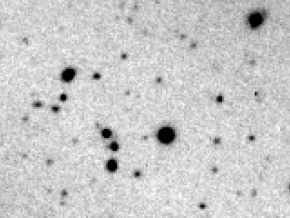(432949) 2012 HH2
 Discovery animation by the Astronomical Research Institute of 2012 HH2 | |
| Discovery[1] | |
|---|---|
| Discovered by | T. Vorobjov |
| Discovery site | Astronomical Research Institute (H21) |
| Discovery date | 19 April 2012 |
| Designations | |
| (432949) 2012 HH2 | |
| 2012 HH2 | |
| TNO[2] · res 4:5[3][4] | |
| Orbital characteristics[2] | |
| Epoch 1 July 2021 (JD 2459396.5) | |
| Uncertainty parameter 2 | |
| Observation arc | 19.16 yr (6,998 d) |
| Aphelion | 40.414 AU |
| Perihelion | 29.201 AU |
| 34.808 AU | |
| Eccentricity | 0.1611 |
| 205.36 yr (75,008 d) | |
| 40.568° | |
| 0° 0m 17.28s / day | |
| Inclination | 28.585° |
| 56.464° | |
| 100.49° | |
| Physical characteristics | |
| 255 km (est.)[3] | |
| 0.09 (est.)[3] | |
| 6.38[1][2] | |
(432949) 2012 HH2 is a resonant trans-Neptunian object, approximately 255 kilometers (160 miles) in diameter, located in the outermost region of the Solar System.[3] It was discovered by Slovak astronomer Tomáš Vorobjov from images taken on the night of 19 April 2012, at the Astronomical Research Institute (H21) in Illinois, United States. This minor planet was numbered (432949) by the Minor Planet Center on 4 April 2015 (M.P.C. 93615).[5] As of 2021[update], it has not been named.
2012 HH2 is a resonant trans-Neptunian object in an uncommon 4:5 resonance with Neptune (DES: 5:4E).[3][4] It orbits the Sun at a distance of 29.2–40.4 AU once every 205 years and 4 months (75,008 days; semi-major axis of 34.81 AU). Its orbit has an eccentricity of 0.16 and an inclination of 29° with respect to the ecliptic.[2] It is currently 29.8 AU from the Sun.
As of 2021[update], no rotational lightcurve of 2012 HH2 has been obtained from photometric observations. The body's rotation period, pole and shape remain unknown.[2] Johnston's Archive estimates a mean diameter of 255 kilometers (160 miles), using a standard magnitude-to-diameter conversion with an assumed albedo of 0.09.[3] Astronomer Mike Brown gives a nearly identical estimates of 253 kilometers (160 miles) for the object's diameter with an albedo of 0.08 and an absolute magnitude of 6.3.[6]
References
[edit]- ^ a b "432949 (2012 HH2)". Minor Planet Center. Retrieved 19 July 2021.
- ^ a b c d e "JPL Small-Body Database Browser: 432949 (2012 HH2)" (2021-06-06 last obs.). Jet Propulsion Laboratory. Retrieved 19 July 2021.
- ^ a b c d e f Johnston, Wm. Robert (18 August 2020). "List of Known Trans-Neptunian Objects". Johnston's Archive. Retrieved 19 July 2021.
- ^ a b "Orbit Fit and Astrometric record for 432949 (Type: 5:4E)". Southwest Research Institute. Retrieved 5 January 2019.The Deep Ecliptic Survey Object Classifications
- ^ "MPC/MPO/MPS Archive". Minor Planet Center. Retrieved 19 July 2021.
- ^ Brown, Michael E. "How many dwarf planets are there in the outer solar system?". California Institute of Technology. Retrieved 19 July 2021.
External links
[edit]- MPEC 2012-H36 : DAILY ORBIT UPDATE (2012 APR. 21 UT) (Discovery mention on Daily Orbit Update)
- MPEC 2012-L20 : 2012 HH2 (Revision to MPEC 2012-J31)
- Home page of the Astronomical Research Institute
- (432949) 2012 HH2 at the JPL Small-Body Database
